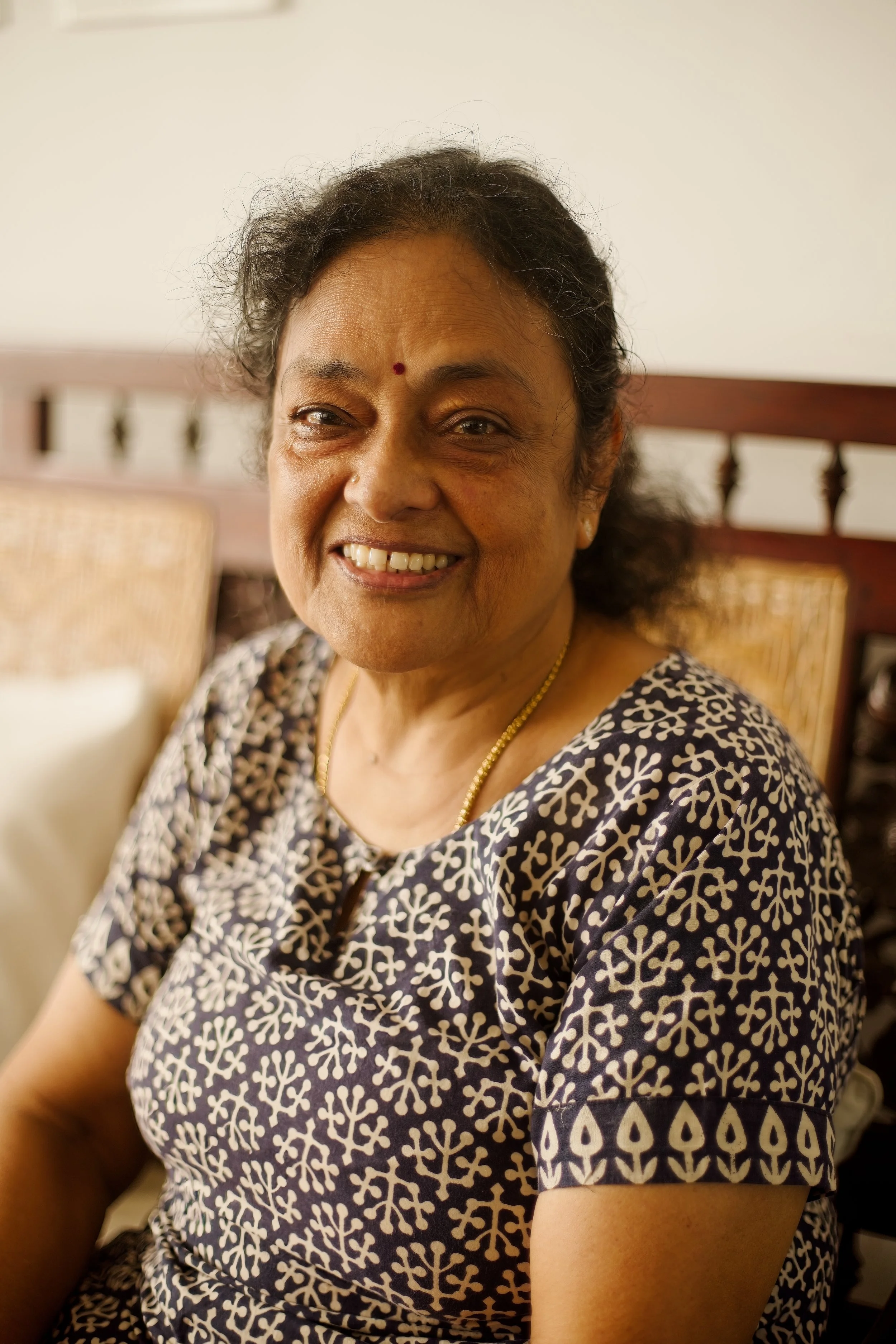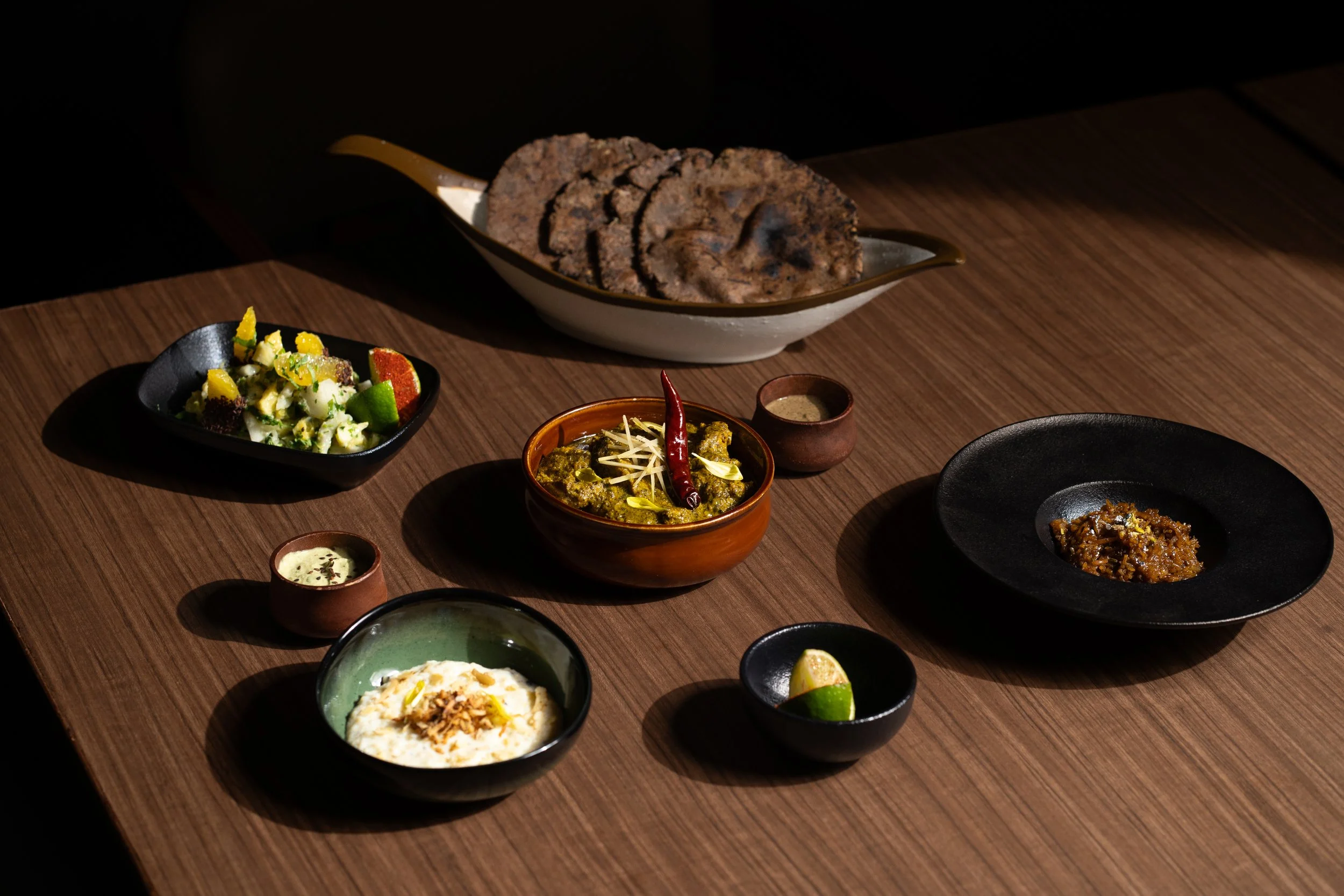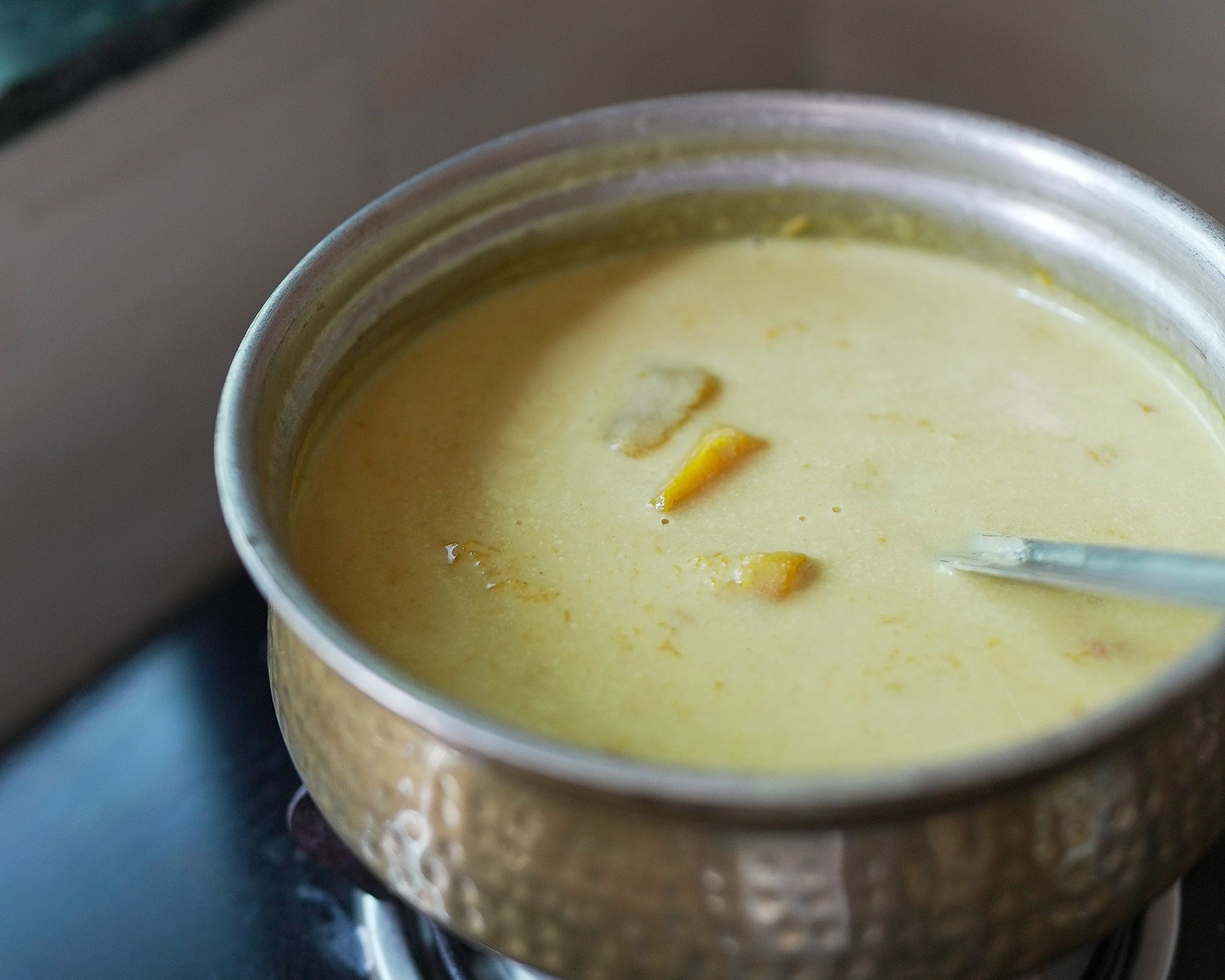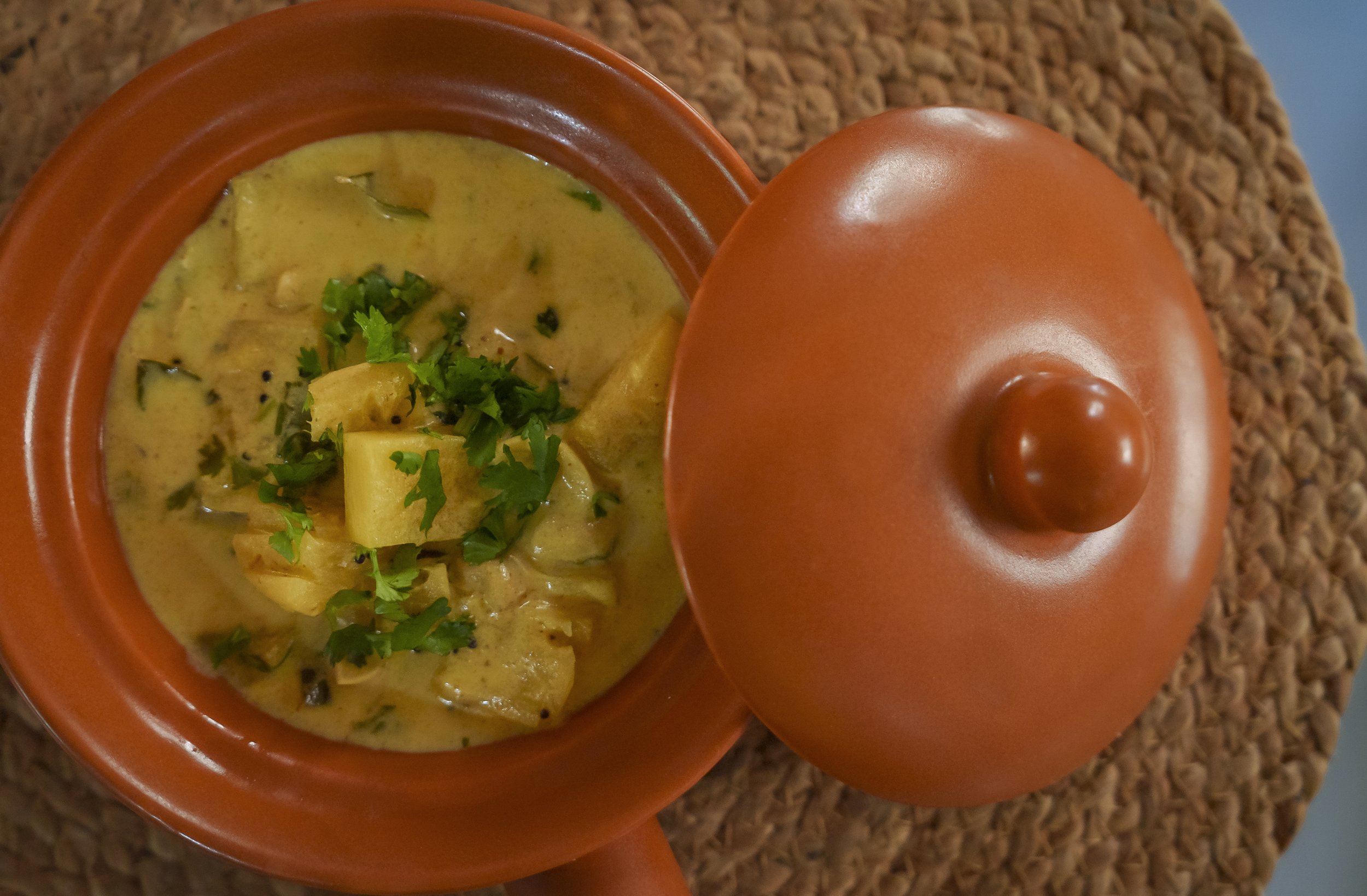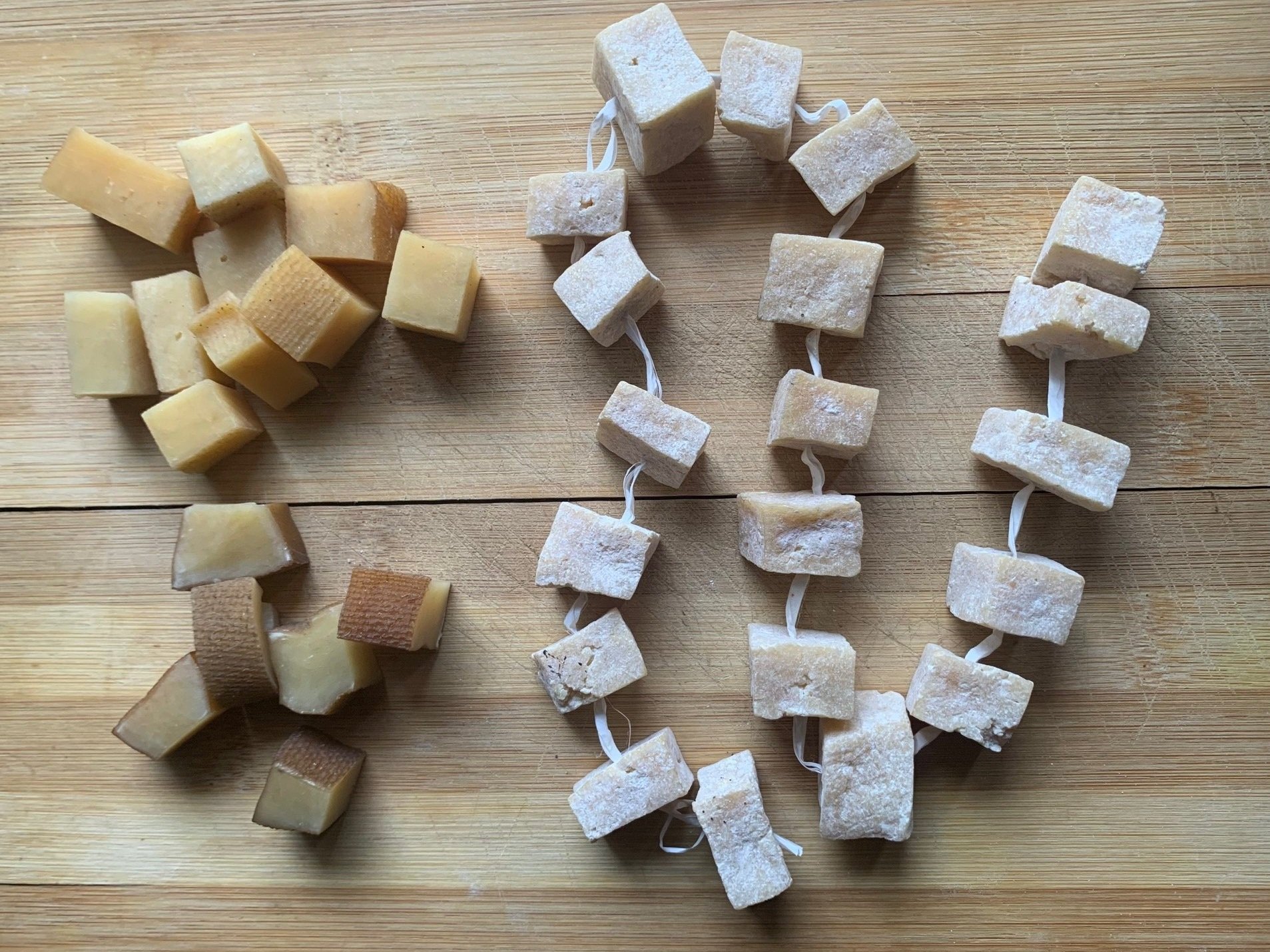A Creole Spice Mix Stars in Pushpa de Canaga's Ridge Gourd with Prawns

At Goya, celebrating home cooks and recipes have always been at the heart of our work. Through our series, #1000Kitchens, we document recipes from kitchens across the country, building a living library of heirloom recipes that have been in the family for 3 generations or more. In this edition, Anita and Pushpa de Canaga talk to Ruth Sequeira about Pondicherry Creole cuisine, best represented by the spice mix vadouvan, which stars in a ridge gourd dish with prawns.
This season’s stories are produced in partnership with the Samagata Foundation—a non-profit that champions meaningful projects.
I drive across the little river to a part of Pondicherry that most tourists do not visit, to eat a cuisine that is mostly unavailable today. I am enroute to Chez Pushpa, a table d'hôte started by Anita de Canaga as a way of sharing the food she grew up eating, Pondicherry creole. We hug as we exchange our bonjours and vannakams, typical multilingual greetings in this little town.
I know Anita through her work at Helping Arts, a platform that helps revive disappearing Indian crafts by selling their products globally. Clearly, preserving her culture is important to Anita. Born in Pondicherry and brought up in Paris, she rediscovered India as an adult. She represents the many traits of Pondicherrians that I admire — multicultural, cosmopolitan yet proudly rooted in their heritage.
The menu at Chez Pushpa is simple home food made by Anita’s mother, Motchamary Pushpam or Pushpa. A small woman with an infectious smile, she comes across as shy. As the conversation steers to food, she quickly sheds her mild manners and shoots out instructions crisply. On entering, she asks if I’m hungry. I say, ‘I’ll wait until lunch’. She looks disappointed but doesn’t accept the answer. She disappears into the kitchen and comes out, a little while later, with a plate of cha gios (spring rolls) stuffed with pork, chicken and prawns.
Anita de Canaga.
Her mother, Puspha.
I am not surprised to see a plate of cha gios in a Pondcherry household.
Pondicherry and Vietnam were strongly intertwined through their common French colonizers. Many families crossed the seas, as part of the French administration, either in the military or for trade. Vietnamese cha gios were a common street food available in Pondicherry until the 90s. Pushpa smiles as I gobble up the rolls. Our friendship is now established.
Anita’s grandfather lived in Vietnam for 45 years along with his second wife, her grandmother Silouvaiammal. During the first Indo-China war in the 1950s, the family was forced to move back to Pondicherry. Here Anita’s father, Noel de Canaga, was married to Pushpa, who was 19 at the time. Pushpa grew up in Tirupur, Tamil Nadu, a relatively conservative Hindu town. “I had not eaten beef until I moved to Pondicherry. I found the town, its cooking and customs quite intimidating,” she says, adding that it was her mother-in-law Silouvaiammal who held her hand through the change. “She spoiled me. For the first few years, my husband and I would be served filter coffee in bed.” recalls Pushpa.
In the ‘80s, Noel and Pushpa and their children emigrated once more, this time to Paris.
Vadouvan is a spice mix that originated in Pondicherry but is mistakenly considered a French spice blend.
Now that I have finished my stack of cha gios, Pushpa leads me into the kitchen and reveals her jar of vadouvan. I am delighted to finally meet this mystery masala. I first heard of this masala in 2018, from a chef in Corsica. I was ashamed that a French chef on a small island in the middle of the Mediterranean knew more about something typically Pondicherry than I. Vadouvan is a spice blend that originated in Pondicherry, and is made from whole mustard seeds, fenugreek, cumin seeds and the star ingredients - onion and garlic. The spices are mixed, dried in the sun, mixed with castor oil, and rolled into balls. While it is often (wrongly) referred to as French Curry, it is derived from the native Tamil masala mix vadavam or vadagam, with minor adjustments and a more French sounding name.
“Vadouvan was made at the start of every summer. I remember us kids playing in the garden while keeping an eye on the Vadouvan as it dried in the sun.” says Anita. “And us adults, keeping an eye on the kids and the ripe mangoes”, quips her mother with a chuckle.
Google Vadouvan and you’ll see that it had its moment in the early 2000s when it began appearing in well established restaurants in France and America. A recipe featured in [the now shut] Gourmet magazine by its acclaimed editor Ruth Reichl furthered its popularity. As the ‘It’ spice of the time, vadouvan entered more foreign kitchens, often being mistakenly introduced as a French spice blend. Interestingly, model and author Padma Lakshmi, in an interview with Thrillist, defends the origins of this spice, quoting, “Vadouvan is a French name that colonial French people [gave] to a collection of spices they discovered in Pondicherry, South India. So don’t even tell me what Vadouvan is… Cultures are raped and pillaged for their gold, for their spices, for their silk and then repurposed. Like all of a sudden they’re the property of that colonial ‘discovery’”.
I ask Anita what she thinks of Padma’s reaction. She laughs it off. “Vadouvan is as Pondicherrian as I am. So what if we both spent a lot of time in France?”
Anita and Pushpa are using this vadouvan to make a weekday lunch staple, ridge gourd with prawns. Mother and daughter look very comfortable in the small kitchen, each picking up their tools and their designated spots. They work in tandem: as soon as one washes the ridge gourd, the other begins to dice it. One gets the pan going, the other pulls out the prawns. At no point do they step on each other's toes. it’s almost like watching a well-choreographed waltz. As they cook, they banter in a mash of Tamil, French and English. This is truly a Pondicherry kitchen.
Two precious tablespoons of vadouvan are added to the simmering oil, and within seconds, the kitchen is enveloped in a wholesome aroma of fragrant garlic, onion, and the punch of mustard. Pushpa learnt how to prepare vadouvan through Silouvaiammal. “Together, we would make about six to seven kilos of vadouvan every summer, for use throughout the year and to send as gifts to friends and family in France,” she says. “Every year we finish about 4-5 jars of the vadouvan in our own home, using it for making chutneys, sambhars (with mutton!) or simple poriyals such as the one we are making today.”
At the dining table, banana leaves showcase our feast: a classic Tamil fish kuzhambu (tamarind stew), white rice, a salade Creole (salade Russe /Russian salad) and the ridge gourd with vadouvan. It is a fresh and light dish, with the gourd providing a subtle base for the prawns. But, the true magic lies in that spice mix.
PUSPHA DE CANAGA’S RIDGE GOURD WITH PRAWNS AND VADOUVAN
Serves 4 people
Ingredients
3 ridge gourd: peeled and cut into medium chunks
150 g cleaned prawns
2 teaspoons vadouvan masala
1 tsp sambhar masala powder
Salt to taste
1 onion: finely chopped
2 garlic pods, crushed whole
A few curry leaves
3 tbsp oil [coconut oil or groundnut oil]
Method
In a pan, heat the oil of your choice. Once the oil is hot, add the vadouvan and temper it for a few seconds [do not burn].
Add the onions, curry leaves and garlic.
After two minutes, add salt to taste.
Add the ridge gourd, prawns and the sambhar masala powder and do a quick stir of all the ingredients. Do not cover with a lid.
Cook till there is no water left in the pan, for about 5-7 minutes. Your ridge gourd with prawns is ready to eat.
Words by Ruth Sequeira. Photos by Sharanya Chander.
Special thanks to our sponsors.
ALSO ON GOYA

